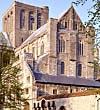 On
the eve of the Norman Conquest, Winchester was the principal city of the English
kingdom. Here was kept the royal treasury and the records of government, such
as they were. Here, too, were the ancient palace of the kings of Wessex, the
Old Minster, Cathedral church for a large part of southern England, along
with two other royal monastic houses, New Minster and Nunnaminster, and the
Bishop's palace at Wolvesey.
On
the eve of the Norman Conquest, Winchester was the principal city of the English
kingdom. Here was kept the royal treasury and the records of government, such
as they were. Here, too, were the ancient palace of the kings of Wessex, the
Old Minster, Cathedral church for a large part of southern England, along
with two other royal monastic houses, New Minster and Nunnaminster, and the
Bishop's palace at Wolvesey.
Barely a month after the battle of Hastings, Winchester surrendered without a struggle to the forces of the Conqueror, opening the way for a flank march around London and William's coronation in Westminster Abbey on Christmas Day.

 In
the early weeks of 1067 the vast building programme which was to change the
face of the Anglo-Saxon city was begun with the construction of a Castle in
the south-western portion of the walled area. Two streets, a lane and more
than sixty houses were destroyed in its creation. Similar disruption was caused
by the enlargement about 1070 of the royal palace, immediately to the west
of the Cathedral, to nearly double its previous size. Little is known of this
complex, but the scale and intent expressed by construction of the adjacent
Norman Cathedral, begun in 1079, are plain to see. Equalled in its time only
by St Hugh's construction at Cluny, this was a building designed to reflect
the eminence of Winchester in royal and ecclesiastical affairs.
In
the early weeks of 1067 the vast building programme which was to change the
face of the Anglo-Saxon city was begun with the construction of a Castle in
the south-western portion of the walled area. Two streets, a lane and more
than sixty houses were destroyed in its creation. Similar disruption was caused
by the enlargement about 1070 of the royal palace, immediately to the west
of the Cathedral, to nearly double its previous size. Little is known of this
complex, but the scale and intent expressed by construction of the adjacent
Norman Cathedral, begun in 1079, are plain to see. Equalled in its time only
by St Hugh's construction at Cluny, this was a building designed to reflect
the eminence of Winchester in royal and ecclesiastical affairs.
 The reconstruction of Nunnaminster
- the nunnery founded by Alfred the Great's queen - by 1109 and the relocation
of New Minster to the northern suburb of Hyde in 1110 may represent stages
in a grand plan to re-invent Winchester as a Norman city. Yet further work
by Bishop Henry de Blois between 1129 and 1171 made Wolvesey one of the greatest
Romanesque houses in England.
The reconstruction of Nunnaminster
- the nunnery founded by Alfred the Great's queen - by 1109 and the relocation
of New Minster to the northern suburb of Hyde in 1110 may represent stages
in a grand plan to re-invent Winchester as a Norman city. Yet further work
by Bishop Henry de Blois between 1129 and 1171 made Wolvesey one of the greatest
Romanesque houses in England.
K. Qualmann
Winchester City Museums